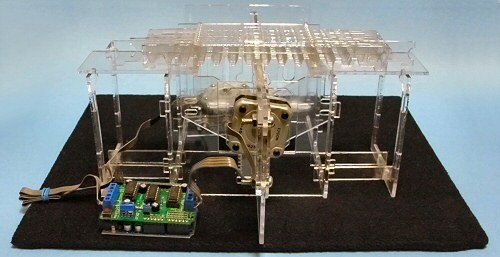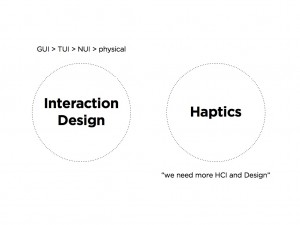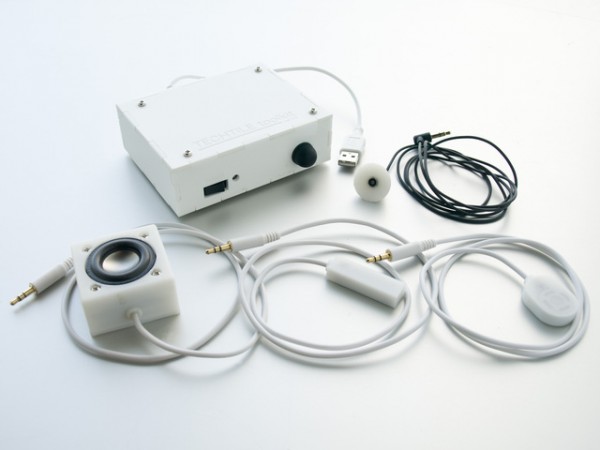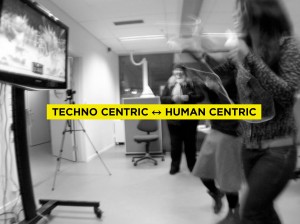IxD Fall Summit 2012 + PhD dissertation
Interaction Design Fall Summit 2012 + Camille Moussette’s PhD Dissertation
October 29-30 2012 at Umeå Institute of Design, Umeå University, Sweden.
Talks, panel discussion and doctoral dissertation (Simple Haptics) with Bill Verplank, Bill Buxton, John Zimmerman, Jonas Löwgren and Kristina Höök!
Register before October 19 at http://www.uid.umu.se/summit
Simple Haptics, done !!!!
Finally, it’s over! I sent my files to the printer last week and today I got the first batch of 25 copies. These are digital prints which 15 of them have to be hand-in at the main library on campus, and the other copies are sent to the grading committee members and opponent.
Phew, the last 6 weeks were really intense. I still can’t believe it’s over somehow. There are a bunch of small things I have to do during the coming days (preparing the offset print batch, nailing/spikning at the library, etc.).
Print copies should be available later this month. In the meantime, you can download a PDF version at http://www.simplehaptics.se
Paper accepted at HAID 2012!
After a few years, our work in finally accepted for publication. Yippi!!!
In the summer of 2008, I participated in the eNTERFACE workshop in Paris, France. I teamed up with Charles Verron, Emma Murphy and Catherine Guastavino for 4 weeks and we worked on an audio-haptic interface project. Our initial goal was to publish the study in a journal. Despite a number of revisions and rebuttal letters, and over two years of back and forth email exchange, it was turned down. We opted for a plan B and decided to submit it to an alternative venue that is relevant and appropriate: The Seventh International Workshop on Haptic and Audio Interaction Design (HAID). We had to reduce the lenght of our article quite much, so we still have content worthy of a journal publication in my opinion. We’ll resubmit it eventually for a journal publication for sure. But for now, I’m quite happy to see our work finally accepted for publication, after ~4 years.
http://www.english.certec.lth.se/haptics/HAID12/program.html
Bits and pieces of June 2012
Artificial Skin Gives Robots the Sense of Touch, University of Southern California, link
What does a robot feel when it touches something? Little or nothing until now. Researchers at the USC Viterbi School of Engineering publish a study in Frontiers in Neurorobotics showing that specially designed robots can be taught to feel even more than humans.
Simulation of squeezing of elastic objects, Whole Hand Haptics, Uppsala University, link
To feel object elasticity is important to identify objects in the world around us, and it is particularly important in surgery for manipulation of soft tissue.
Touchy, Eric Siu, link
This project is a phenomenological social interaction experiment that focuses on the relationship of giving and receiving by literally transforming a human into a camera. Touchy, (the person wearing the device) is blind most of the time until you touch his/her skin. Once vision is given to Touchy, he/she can take photos for you. This human camera, with its unique properties, aims at healing social anxiety by creating joyful interactions.
SHIRI, a japanese butt robot that responds to touch, link
Information Systems graduate student Nobuhiro Takahashi at Tokyo’s University of Electro-Communications has been working on SHIRI, a “humanoid buttocks robot” that is primed to express “various emotions with organic movement of the artificial muscles.” Very weird !!!
Haptic Explorations, Marco Triverio, link
“The Key and the Pump are experimental haptic interfaces. They faithfully reproduce the feeling and the haptic feedback of a real key and a real pump, associating them with on-screen animations. The Key “cranks up” a stop-motion video, while the Pump can be used to excite digital bubbles.” From a 24h design class taught by Bill Verplank at CIID. Great work, I like it :-)
Fanatec ClubSport Pedal, link
The CSR Elite Pedals are the most affordable set on the market that use load cell brake technology. With a load cell, muscle memory is used versus positional memory as the load cell is engaged. Load cell brakes are used to simulate the feel of a real world car. With a vast array of adjustability , you can make the CSR Elites load cell brake go from something similar to a street car up to a very stiff racing brake. With ABS vibration simulation!
Tactus, link
Completely transparent physical buttons that rise up from a touchscreen surface on demand.
Feel Me, link
A sweet, playful connection with the person on the other side.
PhD pre-seminar with Jonas Löwgren
The last few months have been dedicated to writing. It’s been a challenging journey but a good one. I never realized that writing text would trigger so strong intellectual questions and reflection. But it did and it’s hard to describe really.
So this week, on May 22nd, I had my pre-seminar review at Umeå Institute of Design. The purpose of the activity is to offer a substantial review of my thesis manuscript before finishing it up. It is not a mandatory evaluation, but it is fairly common in swedish PhD education I was told. It allows critical feedback while there is still time and possiblity to change the manuscript.
So in early May, I produced a draft version of my text, 80% ready/complete, and submitted it to my advisor and reviewer. I was very fortunate to have Jonas Löwgren, from Malmö University, as a reviewer. Jonas is a researcher I greatly respect and admire. His work on sketching/prototyping for interaction design has been very inspirational, and whenever he says something, it is so clear, articulate, almost stupefying with cleverness.
So the pre-seminar session started at 9h00 and lasted a good 3 hours, up till lunch. Jonas and others provided amazing feedback. It was immensely constructive, a lot more than I expected. Jonas was able to grasp the core aspects of my PhD project, and teared it in pieces, in a good way. Not to destroy it necessarily, but to dissect and analyze my contribution, and force me to better articulate my claims and position.
I’ll take a few days off to digest everything, and then back to writing for the final version.
DeSForM 2012: Learn to Make, Make to Learn
I’m now in Wellington (New-Zealand) for DeSForM 2012, the 7th International Workshop on the Design & Semantics of Form & Movement. This is a small gathering of designers and researchers sharing an interest for Interaction Design and issues of aesthetics, meaning and making. I attended the the workshop in 2010 and was impressed by the relevance of the discussions and considerations in relation to my own design inquiries.
The event was hosted by the Victoria School of Design. I presented my talk Learn to Make, Make to Learn: Reflections from 4 Sketching Haptics Workshops (PDF) during the second day. I think it was fairly well received. It was really nice to present right after Vicky Teinaki and her talk Informing Form: An Aesthetics of Touch. Vicky is pursuing a PhD on the how designers can develop a refined language of touch, so we definitely have some shared motivations!
Bits and pieces of March 2012 [updated]
TECHTILE toolkit, link and techtile.org
TECHTILE = TECHnology based tacTILE design. Best Demo Award at Haptics Symposium 2012. A simple but very elegant toolkit to discover and experience haptics.
Tactile Display With Directional Force Feedback, link
Nokia Patents Haptic Tattoo Technology, link
A lot of speculation and hype around this, but it is still interesting to see how the media/public is picking up on the idea.
Immersion HD Integrator, link
Lots of customs implementations of haptic effects from Immersion.
Game Controller with Embedded Skin Stretch Feedback from HEML Utah, link
As seen at Haptics Symposium 2012 in Vancouver.
Haptic steering wheel from AT&T labs, link
“An underlying thread of this research is, can we develop great haptic and tactile cues that users ‘get’ right out of the box?” Good question!
Cadillac Safety Alert Seat, link
Directional tactile sensation — vibrations of the driver’s seat bottom — to warn of crash threats while driving and parking.
Robot hand to give your videoconferencing the ‘human’ touch, link
Believable human touch factors: texture, temperature and sufficient grip force.
TU/e lecture: Designing Haptics
Here are the slides [PDF, 48 MB] from my Designing Haptics lecture with MA students in Eindhoven (TU/E) on February 27 2012. This introduction presentation was part of a week-long module titled Design for Intersubjectivity through Haptics with tutors/teachers Stoffel Kuenen (UID, Sweden) and Jelle Stienstra (TU/e, the Netherlands).
The first part of this presentation digs into the difference between sketching and prototyping, and how designers might be able to sketch with tech and haptic material. The second part explores haptics, the sense of touch, common haptic interfaces and uncover where/how designers can work with haptics. I gave this lecture form Canada over Skype and apparently the audio was choppy on their end of the atlantic. I hope it was understandable to some extent. Thanks to Stoffel for arranging this lecture, and I’m very curious to see what the students develop and build out of this module.
Bits and pieces of February 2012
Makeblock, link
An aluminum version of “Lego” for building robots and mechanical structures. No price yet. Looks interesting, especisally with the inside threaded slot design and adjustable components. Check out more details at http://makeblock.cc/features-of-makeblock
Haptic Design, Keynote Presentation. David Birnbaum, Immersion, link
Immersion HD Haptics, Immersion, link
Retrofitted Nexus S with piezo actuators, and demos: maracas and rolling ball, classics!

Audrey Braille Display, by David Pankhurst, link
Open Hardware Braille display, using an Arduino and laser-cut acrylic. Nice work.
Daily Haptics, from Marie Rouillon, material designer, link
Copy/paste from her site “As a textile designer, I am particularly interested in what we call the sense(s) of « touch ». – Which probably includes hundreds of different senses : our fingertips for instance can feel warmth, cold, pleasure, pain, pressure, and an infinite array of textures. – How sad is that we are losing our awareness of this plurality ? Moreover, the sense of touch is critical for human functioning at many different levels, from controlling the body to perceiving the environment. As our senses act just like muscles, if we don’t exercise them they lose strenght ! We might end up losing them if we lose our awareness of their importance.
`Daily haptics´ has emerged as a response to this insight, through my design, I am creating tactile experiences in order to reconnect people with tactility, and make them aware of this ability they fail to acknowledge those days.”
Haptics, Mobile Handhelds, and other “Novel” Devices, The Tactile Unconscious of Reading across Old and New Media, by Rachel Lee, link
The “Electronic Touch”, tv report on haptics at Immersion
More on the Haptics youtube playlist from FUTRS.com
The Cryoscope Haptic Weathervane, by Robb Godshaw, link
A haptic weather forecasting device. The Cryoscope shows the user exactly what to expect outside by haptically exhibiting exactly how cold or warm it is to be outside. The user simply touches an aluminum cube that has been heated or cooled to the appropriate temperature. The unit fetches weather data from the internet, and translates it to the cube physically, pumping heat in or out of the cube.
Aesthetics of Touch, blog, from Vicky Teinaki, link
“Finding designers’ language of haptic qualities”. Great posts related to hatpics, touch, making and more. Vicky is a PhD student from Northumbria University in the UK. Her personal site: http://vickyteinaki.com
Bits and pieces of January 2012
Haptics Technologies presentation from Texas Instruments
Good overview and interesting graphs.

Tactus, dynamic Tactile Layer, link
“What if buttons could morph out of the surface of your device? Tactus Technology has developed a new tactile user interface for touchscreen devices that does exactly that.”
Matias Tactile Pro 3 keyboards, link
Bring back tactile quality to keyboard. “Unlike other keyboards made today, each key is built on an individual Alps Mechanical Switch. They feel better, and you’ll type faster.” Ergo Canada article on mechanical keys switches vs other keyboard technology. Keyswitch force graph.
Haptic Interfaces References by Parisa Eslambolchilar from Swansea Univeristy (UK), link
Mostly old(ish) references, nevertheless a good collection of links and presentations on Haptics.
Arduino Body and Sensor Block, link
Project of enclosures for Arduino and different sensors. I like the exploration on simple and large connector for attaching sensors to the main box. I’m thinking of LittleBits on steroids!
The Videola by Nate Rudolph, link and video
Haptic interface for film editing, it brings back kinetic feedback from film strip editing (browse, splice, cut) to modern video editing software.
TinkerForge Toolkit, link
Modular and extendable open source hardware for electronic prototyping. It reminds me of Phidgets. Stacks, Bricks and Bricklets modules, USB-based, wireless option. Support for many programming language C/C++, C#, Python, Java

MEAM 625: Haptic Interfaces, grad level course at UPenn, link
This class provides a graduate-level introduction to the field of haptics, which involves human interaction with real, remote, and virtual objects through the sense of touch. Check the final projects.


























